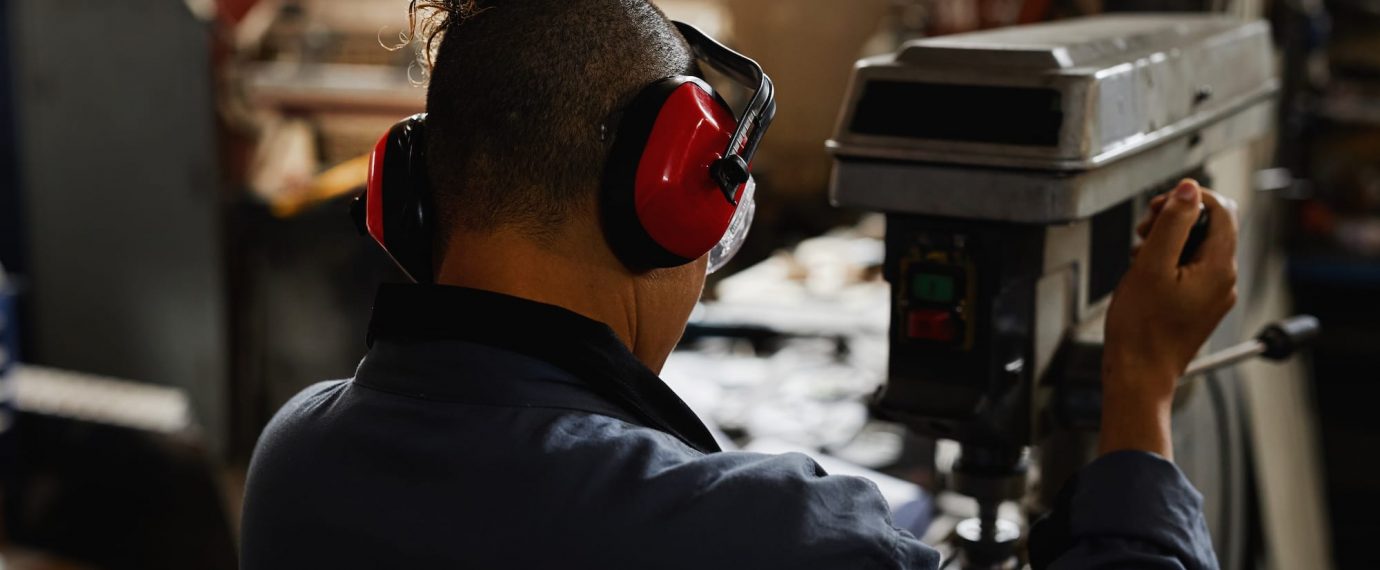By Liz Cox, MS, CSP, Sr. Supervisor – Health & Safety, U.S. Compliance
In the dynamic world of manufacturing, where productivity is paramount, noise often becomes an overlooked concern. However, in the realm of occupational safety and health, noise reduction plays a pivotal role in safeguarding the well-being of workers. In this article, we will explore various facets of noise reduction in manufacturing, ranging from understanding work-related noise exposure to implementing effective control measures.
General Information
Work-related noise exposure poses significant risks to employees’ auditory health. Common equipment and processes can generate surprising levels of noise. Exposure to 85 decibels or higher may cause hearing loss. According to the National Institute for Occupational Safety and Health (NIOSH), millions of U.S. workers are exposed to hazardous noise levels annually. However, occupational hearing loss is largely preventable, emphasizing the importance of proactive measures. Understanding the sources and magnitude of noise within manufacturing environments is paramount for safeguarding workers’ well-being.
Is Noise Monitoring Required?
A crucial aspect of noise management lies in thorough monitoring. Compliance with regulations, such as those set forth by the Occupational Safety and Health Administration (OSHA), mandates implementing a comprehensive monitoring program. The general testing requirement (1910.95(d)(1)) indicates that if any employee’s exposure may equal or exceed an 8-hour time-weighted average of 85 decibels, the employer shall develop and implement a monitoring program. By understanding the noise levels within facilities and comparing them against established exposure levels, we can ensure compliance and take the necessary actions to protect employees. Let’s delve into the requirements and implications of noise monitoring in manufacturing settings.
Exposure Limits
Setting exposure limits is important to mitigate risks associated with noise-induced hearing loss. OSHA defines permissible exposure limits and action levels, outlining thresholds that necessitate protective measures. By adhering to these standards and regularly assessing exposure levels, organizations can uphold safety standards and prioritize the well-being of their workforce.
Types of Monitoring Equipment
To effectively monitor noise levels, organizations utilize various types of equipment, including dosimeters and sound level meters. Sound level meters give an instant result, while dosimeters provide the average noise level of the entire sampling time. Each type serves distinct purposes, from providing instantaneous readings to capturing time-weighted averages. Understanding the nuances of these monitoring tools empowers organizations to conduct comprehensive assessments of noise exposure.
How Often Should I Conduct Noise Testing?
Determining the frequency of noise testing is crucial for maintaining compliance and ensuring ongoing safety. While there are no specific mandates regarding testing intervals, establishing baseline assessments and conducting periodic tests every three to five years are recommended practices. Additionally, factors such as facility changes and process modifications may necessitate more frequent testing.
How Many IH Tests Should Be Run?
Determining the number of Industrial Hygiene (IH) tests required depends on various factors, including the complexity of the manufacturing processes, the size of the facility, and the distribution of noise sources. By conducting a representative sample of tests tailored to the specific site conditions, organizations can obtain accurate insights into noise exposure levels.
What Are Significant Noise Levels?
Significant noise levels, as defined by regulatory standards, denote thresholds at which protective measures must be implemented. Understanding these levels, including permissible exposure limits (PEL) and action levels, enables organizations to establish proactive measures to mitigate risks and protect employees from excessive noise exposure.
Permissible Exposure Level (PEL):
- An 8-hour (TWA) level of 90 dB
- Hearing protection is required
Action Level:
- An 8-hour TWA level of 85 dB
- TWA exposures above 85 dB require a Hearing Conservation Program
- Hearing protection is recommended
Noise Reduction Methods and Controls
The Hierarchy of Controls (from most effective to least effective) are:
- Eliminate the noise and physically remove the hazard
- Replace the hazard: buy quiet equipment and tools
- Control the noise and isolate people from the hazard
- Reduce exposure time limits
- Protect the worker with PPE
A combination of noise reduction strategies is recommended to reduce overall noise exposure in the workplace. Engineering controls emerge as potent tools in this endeavor, offering a spectrum of solutions to attenuate noise at its source. From reducing the speed of moving parts to implementing barriers and enclosures, manufacturers have a plethora of options at their disposal. Some examples include:
- Reduce speed of moving parts
- Eliminate restricted flow in pipes
- Isolate machinery vibration
- Add sound absorption materials
- Build enclosures around equipment
- Reduce vibrating parts and surfaces
- Install barriers
- Seal enclosures for low-frequency sources
Additionally, administrative controls and personal protective equipment (PPE) serve as complementary measures, further fortifying the defense against excessive noise exposure. Some examples of administrative controls include:
- Changes in the work schedule or operations that reduce noise exposure
- Schedule properly to limit noisy environments
- Limit the number of employees exposed to extremely noisy operations
- Provide periodic relief from noise with quiet break or lunch areas
Likewise, examples of PPE include:
- Plugs
- Inserts
- Earmuffs (Active & passive noise canceling)
- Canal Caps
It is not recommended to use consumer noise-canceling headphones in place of laboratory-tested devices if they are not designed for hearing protection.
Conclusion
In conclusion, effective noise reduction in manufacturing requires a multifaceted approach encompassing monitoring, adherence to exposure limits, and implementation of control measures. By prioritizing employee safety and well-being, organizations can create safer work environments conducive to productivity and long-term success. Reach out to your U.S. Compliance Representative for noise dosimetry testing or other industrial hygiene services.



